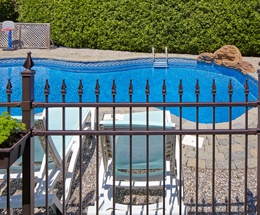Pools and ponds can make for fun in the sun for you, your family, and friends, but they can also be a liability hazard and attract unwanted guests. It doesn’t matter if you have an in-ground or above-ground pool or a pond on your property; you have a liability exposure with all of them.
Kim Bechler, personal lines senior underwriter, will explain how can you protect others from harm and yourself from a liability claim if you have a pool or pond.
If you have an in-ground pool, it should be enclosed by a fence that’s at least five foot high and has a latching mechanism on all gates that access the pool area. If there’s no fence, it must be protected by an acceptable automatic safety pool cover (check with your insurance carrier to be sure the pool cover meets the safety features required to obtain coverage). This will keep unwanted guests from getting into the pool when you’re not able to monitor or use your pool.

If you have an above-ground pool, make sure the pool is installed to comply with your city’s ordinances. These pools must also have latching gates at any deck steps that lead to the pool. If there isn’t a deck attached to the pool, be sure the ladder is stored away from the pool when not in use.
If you have a pond on your property and your home is insured with West Bend, it’s not necessary to enclose the yard or pond area with a fence. Most properties that have ponds are in rural areas with few or no neighbors in close proximity. A fence may take away from the nature and beauty of a pond.
West Bend can ensure a pool exposure; however, it’s important to take precautions against unwanted guests using your pool in order to prevent a liability claim.
A diving board and/or pool slides are okay for in-ground pools and can make pool time more enjoyable. They can also harm your guests if they’re not installed properly.
Diving boards and pool slides should only be installed on in-ground pools. A diving board should be a diving platform rather than a springboard. The pool depth where the board is located should be at least nine feet. This will provide enough room above the bottom of the pool for a diver to avoid injury.
- Pool slides installed on in-ground pools should be:
- professionally manufactured and installed;
- have handrails leading from the bottom to the top of the slide;
- have walkways and stairs leading to the top of the slide that are made of slip-resistant, rigid materials; and
- be no higher than 12 feet with a water depth at the slide’s drop off between 6-8 feet (depending on the height of the slide).
Diving boards and pool slides should not be installed on above-ground pools because water depths are typically not deep enough to prevent injury.
It’s also not safe to install diving boards or pool slides at your pond. The pond depth can vary from year to year and the bottom of the pond can change over time. A pond can develop debris and weeds. Rocks could surface on the bottom of the pond over time. The water may not be clear enough to see objects submerged in the water, making diving dangerous. For these reasons, neither diving boards nor slides should be installed on your pond.
Some insurance carriers will add more premium for these added exposures so always check with your insurance agent when installing a pool.
Whether you have a pool or a pond, keeping your family and guests safe — and unwanted guests out — will give you a more enjoyable experience for years to come.
SOURCE: WEST BEND, Scott Stueber on Jun 20, 2017 11:32:17 AM
Leave a Reply